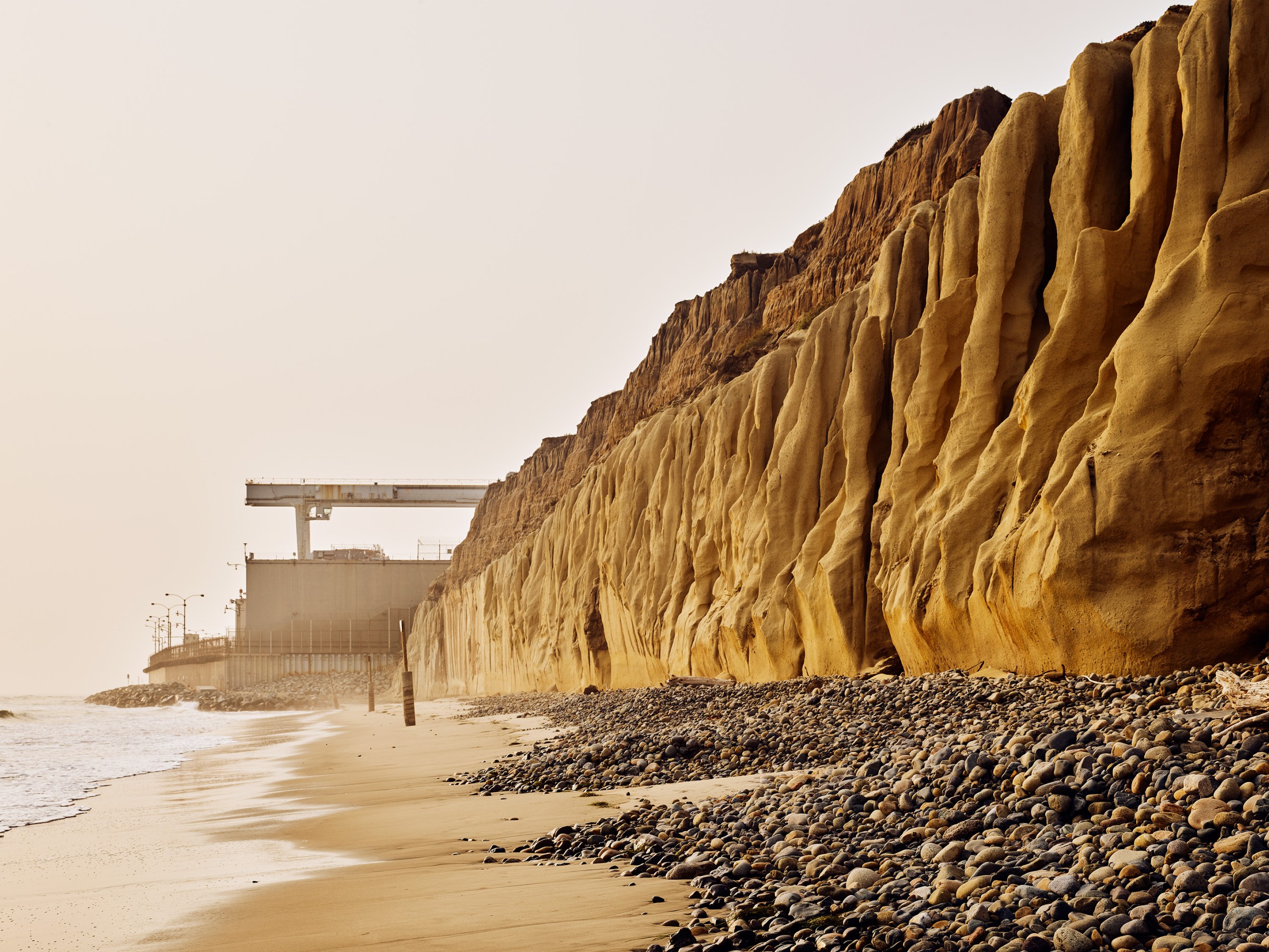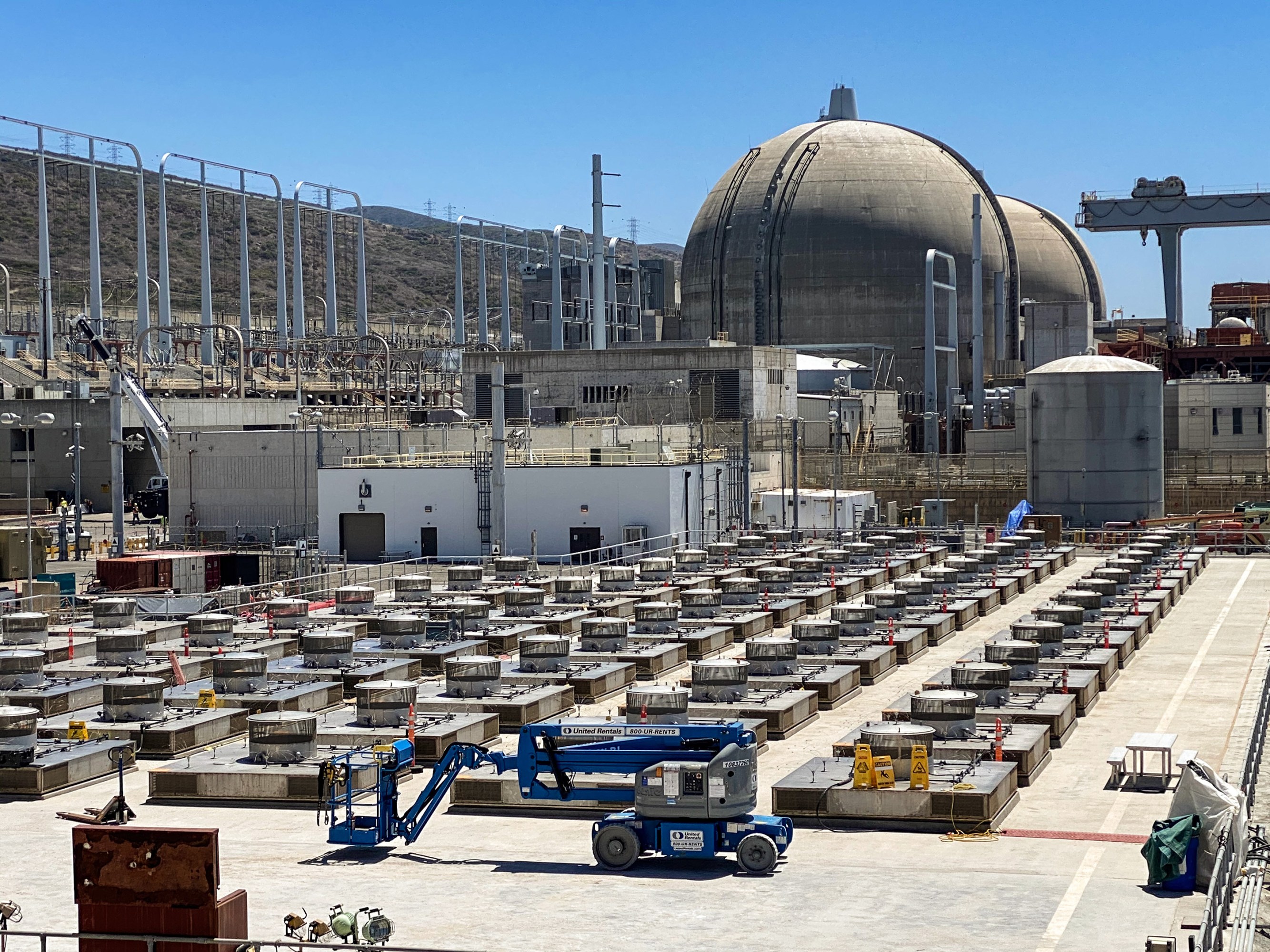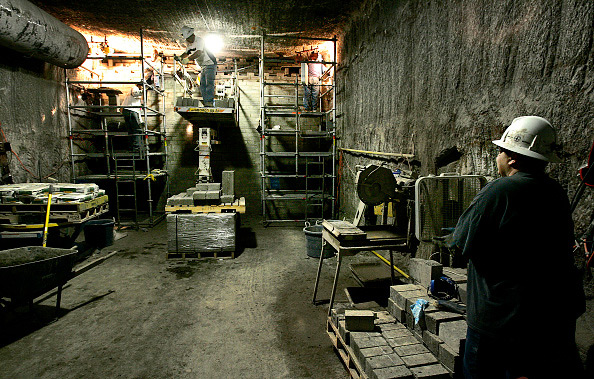Finding homes for the waste that will (probably) outlive humanity
On a seasonably warm day in August along a rugged stretch of the Southern California coast, work crews put on their reflective vests and hard hats. They directed a fleet of heavy vehicles known as cask handlers to haul great white concrete barrels from the decommissioned San Onofre Nuclear Generating Station, known as SONGS. Each cask, about 17 feet tall and weighing 50 tons, was like a set of Russian nesting dolls: entombed inside was a stainless steel canister, which in turn held 37 cylinders of nuclear fuel rods.
Since 2013, when regulators finally decided to shut SONGS down for good, teams of scientists, engineers, and policymakers have been hard at work to make sure it could be safely decommissioned. A total of 123 canisters were taken out of the plant and moved to their new home. Their journey wasn't long-just to another area of the same site, about 100 feet away from the Pacific Ocean and just three feet above sea level. Now, with the spent fuel removed, the power plant itself can be dismantled.
SONGS, sandwiched into the narrow strip between the sea and the highway that connects the urban sprawls of San Diego and Los Angeles, began operations in the late 1960s and churned out carbon-free energy for decades. But in 2012, regulators found extensive issues with its steam generator, an essential component of a nuclear reactor that prevents it from overheating. Replacing the parts wouldn't be economical-one estimate priced it at more than $800 million. Not to mention that SONGS would then have to jump through stringent regulatory hurdles to resume operations.
Shutting down was the only logical decision in front of us," says Doug Bauder, San Onofre's chief nuclear officer.
The US already has 83,000 metric tons of nuclear waste, enough to fill a football field about a dozen yards deep- and the leftovers will keep piling up.
That choice solved one problem, but not another: what to do with all the nuclear fuel that San Onofre had used. Its radioactive waste could outlast the human race, with spent fuel components that include plutonium-239, which has a half-life of 24,000 years, and iodine-129, with a half-life of 15.7 million years. But for now, there's no place to store it permanently.
So SONGS is keeping the rods of spent nuclear fuel in storage holes buried along the seismically sactive California coastline. They are sitting ducks for the next big earthquake, which is likely to hit within the next century. If the nuclear waste somehow got out, the results would be devastating. Even without a quake, the vaults are easy to inundate," says Dan Hirsch, the retired director of the Program on Environmental and Nuclear Policy at the University of California, Santa Cruz, and groundwater can rise up into them."
The plan is to eventually transport the fuel at San Onofre offsite, but where to? The US already has 83,000 metric tons of nuclear waste, enough to fill a football field about a dozen yards deep-and with two dozen plants currently in the process of decommissioning, the leftovers will keep piling up.
In 1982, the US Congress enacted the Nuclear Waste Policy Act, which requires the US Department of Energy to find a geological repository for the spent fuel and take it there. Since 1987, the US government has focused its attention on developing an underground repository at Nevada's Yucca Mountain. However, the site has been a political hot potato, with support for it swaying in response to local opposition and state and federal leadership. As a result, the government has so far been unable to fulfill its legal duty to find a long-term home for America's radioactive waste.
This is a situation where a political solution is needed to solve a technical problem," says Bauder.
Near the state line on Highway 176, which transects southeast New Mexico and west Texas, a white sign introducing visitors to Lea County, New Mexico, reads: Welcome to the EnergyPlex." It's at the edge of the Permian Basin, a large sedimentary region rich in oil, natural gas, and potassium that spans a corner of the two states.
Since the 1990s it's been gaining a reputation as a place to store nuclear material-not the high-grade waste supposedly bound for Yucca Mountain, like the spent fuel rods of San Onofre, but the more ordinary, workaday leftovers of the industry, like gloves, helmets, and soil that have been contaminated with radioactive material. For this, the DOE set up the Waste Isolation Pilot Plant, or WIPP, about 30 miles outside Carlsbad, New Mexico. It was authorized in 1979 but didn't receive its first shipment until 1999. Since then, low-level waste from nearly two dozen nuclear reactors around America has been trucked in and buried over 2,000 feet under the surface. Waste Control Specialists (WCS), a similar facility, was erected just across the state line in Andrews, Texas, around the same time.
The geology of the Permian is ideal for burying nuclear waste for the long haul. For one thing, the WIPP location gets natural protection from a thick layer of salt that surrounds it. Over long periods of time, the salt will flow and the radioactive material will effectively be entombed in that salt," explains Lewis Land, a hydrogeologist at the National Cave and Karst Research Institute in Carlsbad. Most geoscientists, he says, believe that the salt is impermeable, which means there's no chance for the waste to escape into the surrounding environment even if one of the barrels holding the material were to leak. Meanwhile, at the WCS facility, the waste will be covered by a 40-foot-thick layer of impenetrable red clay -which serves the same function as the salt at WIPP-once the storage sites are filled.
 SPENCER LOWELL
SPENCER LOWELLWIPP has been in operation for more than two decades with only a single incident. In 2012, a drum burst. It turned out it had contained not just discarded radioactive material but clay-based organic cat litter. Inorganic cat litter has long been used as chemical stabilizer for nuclear waste, but the organic stuff reacted with radioactive nitrate salts, releasing heat and building pressure until ultimately the drum broke, dispersing radiation throughout the underground facility. The dense salt contained the radiation, but it was an expensive mistake.
In 2008, Carlsbad's then state representative John Heaton saw that Yucca Mountain was having difficulties getting through the political process. He started talking with others about the possibility of temporarily storing high-level nuclear waste at a site about half an hour from Carlsbad. The Eddy-Lea Energy Alliance (ELEA)-a group of local officials in two counties who were responsible for economic development-purchased a 1,000-acre patch of rangeland located along the highway. Holtec, an energy company headquartered in New Jersey, soon expressed interest in developing that land as a storage facility for high-level waste.
We were excited that someone was interested, and thought it was a viable part of their own business plan," says Heaton, who is now the city's energy development coordinator.
At the new Holtec facility, spent nuclear fuel would be shipped in from all over the country and put into interim storage. The proposal for the Holtec site was submitted in 2017 and is still under review by the Nuclear Regulatory Commission. Holtec and ELEA should hear by 2021 whether or not construction can start. If all goes well, the soonest the site could receive waste would be 2023, says Heaton. The waste would be stored in canisters, which would make it easy to retrieve and move once a permanent repository is finally decided upon.
But the nuclear facility won't only provide storage; it could also create stable work. The oil and gas industry has exploded in Carlsbad over the last three or four years, almost doubling the population. Rapid growth has strained resources in the sleepy, rural town, and RV camps-which locals refer to as man camps"-have been set up for oil workers and their families. But these energy industries are particularly susceptible to boom-and-bust cycles: today, there's a slowdown caused by covid-19, since lockdowns reduced the amount of oil required for transportation. Heaton says that nuclear storage could provide more than 200 jobs that would be stable and secure for the very long term.
Despite the economic benefits, some New Mexico state legislators have tried to block the storage facility, citing concerns that it would endanger public safety and other industries. Locals, too, are understandably worried.
There are the unknowns of nuclear," says Nick King, a resident of Carlsbad and the preacher at the Carlsbad Mennonite Church. We're playing with things we don't understand."
Defenders say the Holtec facility won't be a permanent repository, only a resting spot until Yucca Mountain or its replacement is in operation. But the dispute over Yucca has already taken a generation, and farmers who have resisted being pushed out by the oil and gas boom are concerned about how long the waste will sit there. I'd like to know what length of time temporary' means," says Teresa Ogden, a third-generation farmer living in Loving, a town just south of Carlsbad. We don't know the long-term effects. I feel like we're guinea pigs out here."
 Ground control: SONGS keeps its waste buried onsite, which means it is potentially vulnerable to the next big earthquake.SOUTHERN CALIFORNIA EDISON
Ground control: SONGS keeps its waste buried onsite, which means it is potentially vulnerable to the next big earthquake.SOUTHERN CALIFORNIA EDISONIt's not just locals. Tom Isaacs, an advisor to the nuclear industry who is helping San Onofre as it figures out what to do with its nuclear waste, worries that the temporary sites will become effectively permanent-that people would give up the momentum necessary in order to build the final repository and the storage site will be there forever."
People are also scarred by New Mexico's own history with the nuclear industry. The state was home to the test of the first atomic bomb in 1945, which is thought to have caused many cancers and other health problems throughout the basin range that was downwind from the test site.
New Mexico has paid its dues," says Gene Harbaugh, who has lived in Carlsbad for the last 30 years. We don't owe anything to the nuclear industry."
What if we didn't have to create new repositories? What if, instead, sites already designated for nuclear material could store it more safely? That was one of the questions that environmentalist Elizabeth Muller started thinking about in 2015. But when she asked experts what could be done with nuclear waste, she got immediate pushback: People in the business said, There's no appetite for new ideas in nuclear waste. Nothing ever happens in this industry.'" But, she adds, just because nothing has ever happened in nuclear waste doesn't mean you should dismiss it as Nothing's ever going to happen.'"
As relative newcomers to the field, Muller and her father-the physicist and reformed climate change skeptic Richard A. Muller-heard policy advisors and engineers talk about how boreholes, drilled deep in the earth by the oil and gas industries, could also be used for storage. In 2016, the Mullers founded Deep Isolation, a private company based in Berkeley, California, to explore using them for nuclear material.
The company's top priority is to get the waste below ground; accidents above ground can spell catastrophe. But the Mullers realized that one contentious issue plaguing Yucca Mountain and WIPP was the transportation of nuclear waste across state lines.
People don't want nuclear waste coming through their backyard," Elizabeth Muller explains. Deep Isolation plans to circumvent that entirely by burying waste where it is, whether that is around an existing power plant or near some other Department of Energy facility. (Long-term burial at any non-designated facility would require community consent.)
People really want a solution for climate change. There's no smokestack at a nuclear plant, but ... if we're going to deploy more nuclear energy, this waste question is a big one."
Their method involves drilling holes 18 inches in diameter and between 1,000 and 3,000 meters deep, and then drilling sideways to create a place to bury specially designed, corrosion-resistant cylinders that store spent fuel assemblies. Each canister is a little larger than a nuclear fuel rod assembly-more like a glove around the spent fuel than the vast barrels at San Onofre-and they are shuttled down the hole in a chain of two or three.
One benefit of this method, says Muller, is that the same technique could serve for both temporary and permanent storage. In January 2019, Deep Isolation proved that canisters could not only be sent underground but also retrieved, should the DOE manage to create a permanent repository elsewhere at some later point and want to transfer material there.
Their method won't work everywhere, though. SONGS, for example, is located on land that will eventually have to be returned to its owner, the US Navy.
Despite the company's proof-of-principle experiment, others are skeptical that Deep Isolation's method will necessarily be safe.
Lindsay Krall, a geochemist who researches nuclear waste burial at Stanford University, worries that the company's canisters wouldn't be buried deep enough to prevent waste from leaking into the biosphere. What's more, the narrow boreholes can only accommodate thin canisters, which may be insufficient for long-term safety.
There is no reason to expect that borehole disposal of spent fuel will attain cost savings," Krall says. Rather, [it] represents a technological risk, with a significant opportunity for failure that would result in increased disposal costs and decreased public safety."
But John Grimsich, Deep Isolation's director of applied science, says that burial sites they choose will have ideal geology for long-term storage, far away from sources of groundwater. The highest radiation doses that Muller and her colleagues have calculated at the ideal sites are lower by a factor of 10,000 than the average exposure a person receives annually from the planet's background radiation.
Given the amount of waste already out there, some believe it would be more responsible to simply create less of it. But can that be done without giving up nuclear, one of the best carbon-free options for generating energy?
One option is to reuse the waste. In France, nuclear waste has been reprocessed since the dawn of the industry in the 1940s. Since 1976, the nuclear power and renewable energy group Orano has processed more than 36,000 metric tons of used fuel, which is responsible for generating 10% of France's nuclear electricity. Orano's plant recycles around 1,100 metric tons per year.
 Salt of the earth: Men work to seal a salt tunnel in the Carlsbad Waste Isolation Pilot Plant.BRIAN VANDER BRUG/LOS ANGELES TIMES VIA GETTY
Salt of the earth: Men work to seal a salt tunnel in the Carlsbad Waste Isolation Pilot Plant.BRIAN VANDER BRUG/LOS ANGELES TIMES VIA GETTYThe process of recycling nuclear fuel takes years. Spent fuel rods are taken from nuclear reactors and placed in a storage pool to cool for two years. When they get to around 570 F, the fuel rods are packed into steel canisters and brought to the Orano plant in the northwesternmost point in France, in the town of La Hague. After the rods cool below 80 F, they are cut into smaller pieces before being placed in nitric acid and dissolved. Then the recyclable material-a mixture of uranium and plutonium-gets separated from other fission products in the spent fuel and purified. Finally, it is remixed to produce new fuel.
The US has developed its own approved technology for reprocessing, but in 2007 the Nuclear Regulatory Commission decreed that it would be too expensive to pursue without an investment from the DOE-which has not materialized.
Instead, there's growing interest in developing new kinds of nuclear reactors that produce less waste.
Most current plants use generation II or III reactors, which use water to cool down the fuel once its atoms have split. Generation IV reactors use heavier coolants like sodium or molten salt, which is technically challenging but can produce higher levels of power generation with a lower risk of meltdown. One of the companies building sodium-cooled systems, Terrapower, makes reactors that can also run on spent or depleted uranium.
Reprocessing the uranium can significantly reduce waste, says Terrapower's CEO, Chris Levesque. But it doesn't stop waste from being produced altogether. Levesque and others fear that nuclear waste may be intercepted and used to aid in the proliferation and development of nuclear weapons.
In Levesque's long career in the nuclear industry, dealing with waste has been as much of an issue in getting people to accept nuclear energy as the safety of the reactors themselves. People really want a solution for climate change. There's no smokestack at a nuclear plant," he says. But they want to hear about some solution for waste. If we're going to deploy more nuclear energy, this waste question is a big one to answer to people's satisfaction."
The future of nuclear waste spans thousands of years, but plants are being decommissioned right now. Until a final resting place can be decided, temporary repositories-like the Holtec facility or Deep Isolation's proposed boreholes-are appealing options for corralling the waste. The alternative is having it sit above ground, where an accident could have much more immediate consequences.
Still, Dan Hirsch argues that the conundrum is a fundamental ethical issue." It's not appropriate to dump the waste on a minority community in Texas or New Mexico," he says. What's more, moving waste by rail to the Permian might require transportation through the Navajo Nation, which banned that in the 2012 Radioactive Materials Transportation Act.
This generation built nuclear power plants," says Tom Isaacs. We have benefited immensely from electricity with no carbon emissions. We have a responsibility to solve the problem. That takes a repository."